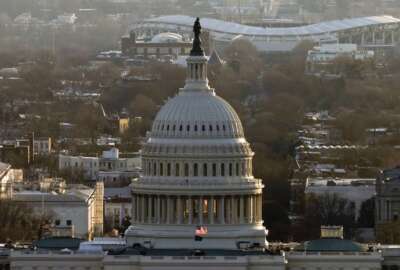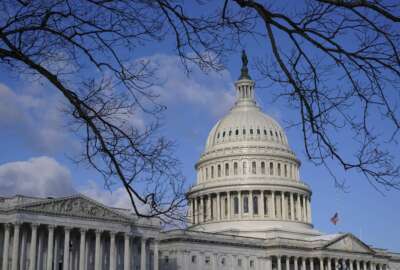CBO: Congress could wring $300B in deficit savings from federal pay, pension changes
A new Congressional Budget Office analysis of proposed deficit-reduction efforts contained half a dozen proposals affecting federal employees, including reducing...
Federal employees have already sacrificed some $100 billion in deficit reduction through a three-year pay freeze, federal unions and advocacy groups contend. But Congress could wring more than $300 billion in savings from federal pay and benefits, according to a Congressional Budget Office analysis released this week.
CBO presented its analysis to the House-Senate budget conference committee at the panel’s second public meeting Wednesday. The committee is negotiating over ways to replace the automatic sequestration budget cuts and to come up with funding levels for the remainder of fiscal 2014.
CBO’s analysis contained half a dozen proposals — out of more than 100 — affecting federal employees, including reducing annual pay raises, requiring federal employees to contribute more toward their pensions and reducing the size of the federal workforce through attrition.
All told, such proposals would reduce federal outlays or increase revenues by $308 billion, according to CBO estimates.
However, CBO noted several times in its report that trimming federal compensation risks making federal service less attractive and could potentially drive away new recruits to the federal workforce.
Increasing feds’ retirement contributions
|
Fed Pay & Benefits Savings
Total: $308 billion |
CBO’s analysis examined a number of changes lawmakers could make to federal employees’ pensions.
Currently, employees under the Federal Employees Retirement System (FERS) — hired before Dec. 31, 2012 — contribute 0.8 percent of their salaries toward their pensions. Employees hired starting in 2013 are required to contribute 3.1 percent of their salaries toward their pensions because of a bill to extend the payroll tax cut passed in February 2012.
Requiring federal employees hired before 2013 to contribute an additional 1.2 percent of their salaries toward their pensions — for a total of 2.9 percent — would increase federal revenues by $19 billion over 10 years, CBO stated. That’s identical to a plan pushed by President Barack Obama in his 2014 budget proposal
Because the proposal would not have any additional effect on new federal hires, it likely wouldn’t affect the quality of new federal recruits, CBO said.
However, it could motivate current employees to leave for the private sector or retire earlier, because “it would reduce the income of federal employees who have already foregone across-the-board pay increases for three consecutive years,” the analysis stated. “Federal employees who have not received salary increases based on merit or length of service have seen the purchasing power of their pay fall by about 7 percent since 2010.”
Moving from high-three to high-five
Additionally, changing the formula under which federal employees’ annuities are calculated — moving from the highest three-year average salary to the highest five-year average salary — for employees who retire beginning in January 2015 would reduce total federal annuities by about 3 percent and save the government $6 billion between 2015 and 2023, according to CBO’s estimates.
If implemented in 2015, it would would affect 67,000 FERS retires and 28,000 CSRS retirees.
CBO said doing so would better align federal pensions with private-sector ones. Also, many private-sector companies have nixed retiree health-insurance benefits and scaled back pensions, while the government, by and large, has not.
“As a result, federal employees receive a much larger portion of their compensation in retirement benefits than private-sector workers do, on average,” CBO stated. “Consequently, reducing pensions might be less harmful to the federal government’s ability to compete with the private sector in attracting and retaining highly qualified personnel than a reduction in current compensation would be.”
However, CBO did note that cutting retirement benefits would make the overall compensation provided by the government less attractive, “which would discourage some people from entering federal service and hamper the ability of the government to retain its current workforce.”
Switching to Chained CPI
CBO also analyzed the effect of switching to using a different measure of inflation — the chained Consumer Price Index — to calculate cost-of- living adjustments for Social Security, military and federal retirees.
Over the past decade, the so-called chained CPI has grown an average of about 0.25 percent more slowly than traditional CPI. If implemented in 2015, overall federal outlays would be reduced by $162 billion through 2023, according to CBO’s estimates.
CBO said the chained CPI is generally regarded a more accurate measure of overall inflation than the traditional method. However, CBO noted that one argument against converting to a chained formula is that many goods and services paid for by Social Security beneficiaries — such as health care — “generally rise faster than prices faced by the population at large,” CBO said.
Capping across-the-board pay increases
Congress could save another $78 billion by capping civilian and military pay increases, according to CBO.
Under the 1990 Federal Employees Pay Comparability Act (FEPCA), civilian employees typically receive pay increases each year — set, by law, at 0.5 percentage points below the annual rate of the increase in the employment cost index (ECI).
But the President and Congress are able to override the mandated increase — and both have in recent years. President Obama initially proposed a two-year civilian pay freeze in January 2011. Congress extended that for another year last March.
CBO said lawmakers could reduce the expected pay increases under FEPCA by another 0.5 percentage points beginning in 2015 and lasting through 2023, and that would reduce federal outlays by $53 billion.
This would significantly decrease the costs of operating federal agencies, because compensation costs make up about 15 percent of total federal discretionary spending, “and it is difficult to attain a significant reduction in that category of spending without constraining personnel costs.”
However, the agency noted it could make federal recruiting efforts more difficult, especially potential new employees with advanced and professional degrees, CBO’s analysis stated.
CBO’s own analyses indicate that less educated federal employees generally earn more in pay and benefits than their private-sector counterparts. However, the gap reverses — and widens — with more highly educated federal employees. Those federal workers with professional and advanced degrees are paid less than similar workers in the private sector, CBO found in a 2012 analysis.
Congress could similarly limit military pay raises at 0.5 percentage points below the annual ECI increase. To put that in perspective, between 2000 and 2010, lawmakers approved military pay raises that exceeded the ECI by an average 0.5 percentage points, according to CBO’s analysis.
Size of the federal workforce
Reducing the overall size of the federal workforce — which is now about the same size as it was 20 years ago — through attrition would net about $43 billion in savings.
CBO’s analysis discussed a proposal that would reduce the number of civilian employees at certain agencies by 10 percent by limiting their authority to hire no more than one employee for every three that leave. Under the proposal, the President would be able to exempt certain agencies because of national security concerns. CBO estimated that about two-thirds of the civilian workforce would be exempt, which would limit total reductions to about 70,000 employees. Even so, doing so would save about $43 billion between 2015 and 2023, CBO said.
CBO’s analysis stated that this proposal could help agencies slim down the “additional layers of management” that are increasingly making up larger swaths of the workforce.
But CBO also pointed to recent trends that suggest the federal workforce “may already be under strain from cost-cutting measures and that further reductions could impede the government’s ability to fulfill parts of its mission.”
RELATED STORIES:
Fed groups: Pay and benefits should be off the table in budget talks
In House-Senate budget talks, feds fear being familiar target
Will new budget negotiations unravel the sequestration riddle?
Copyright © 2025 Federal News Network. All rights reserved. This website is not intended for users located within the European Economic Area.





